
Did you know that according to a study from the University of Virgina, women are 73% more vulnerable than men in a car accident? In addition to the physical and biomechanical differences between women and men (such as the fundamental mechanical properties of bones, ligaments and tissues, differences in the body gravity center or hormonal variations that can affect tissue stiffness and susceptibility to injury), male parameters are taken into account in the development of cars safety equipment. In fact, until recently, there were no female dummies for car accidents testing!
However, when the first female dummies began to appear, they tended to simulate small sized women (1.5 m height and 50 kg weight). Does this correspond to the average of the world female population?
Take a look here to find out an answer: ourworldindata.org
Fortunately, great progress is being made in this field by optimizing the design of female dummies:
www.youtube.com/watch?v=dZoM8J_PYf4.
Many diseases affect mostly women and taking into account that women have been excluded from many clinical trials testing drugs and health treatments, the consequences for the health of this half of the population can be terrible.
Do you know diseases that affect mostly or exclusively women or men? Find out about them and create a table indicating their name, when they were discovered and when an effective treatment for them was found (if so has been achieved).
This Worksheet is part of the Quartely Problem Series. For more quartely problems and other classroom materials, click here.
Picture Source: brgfx’s picture on freepik
CC-BY-NC-SA 4.0 licence granted
Content-related competences
